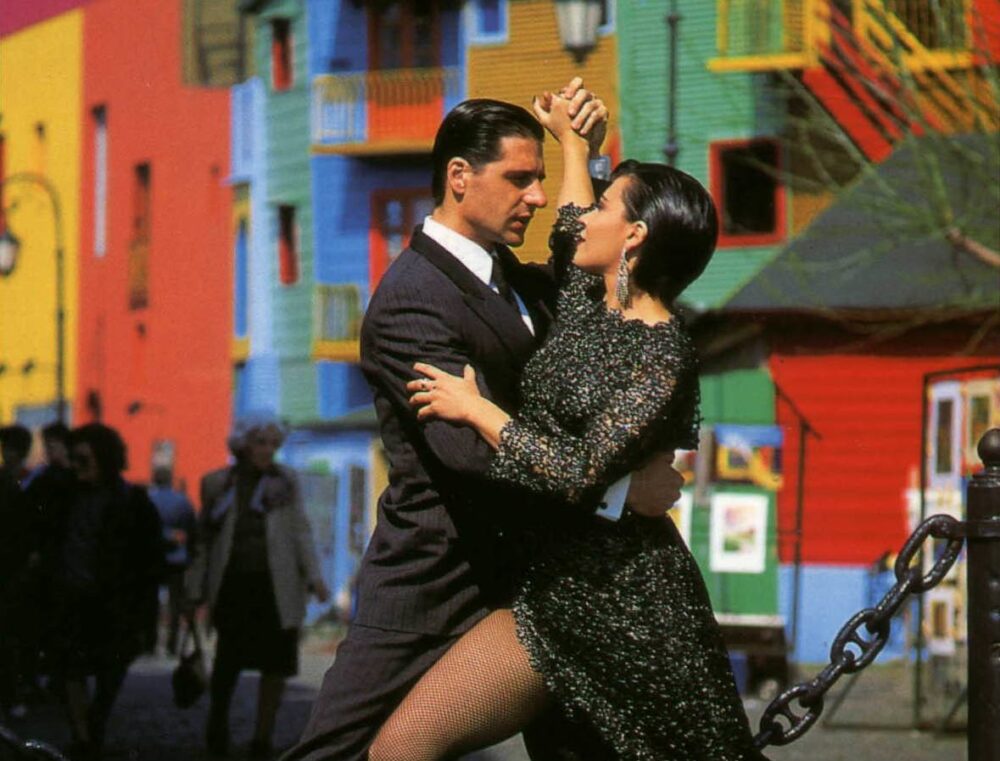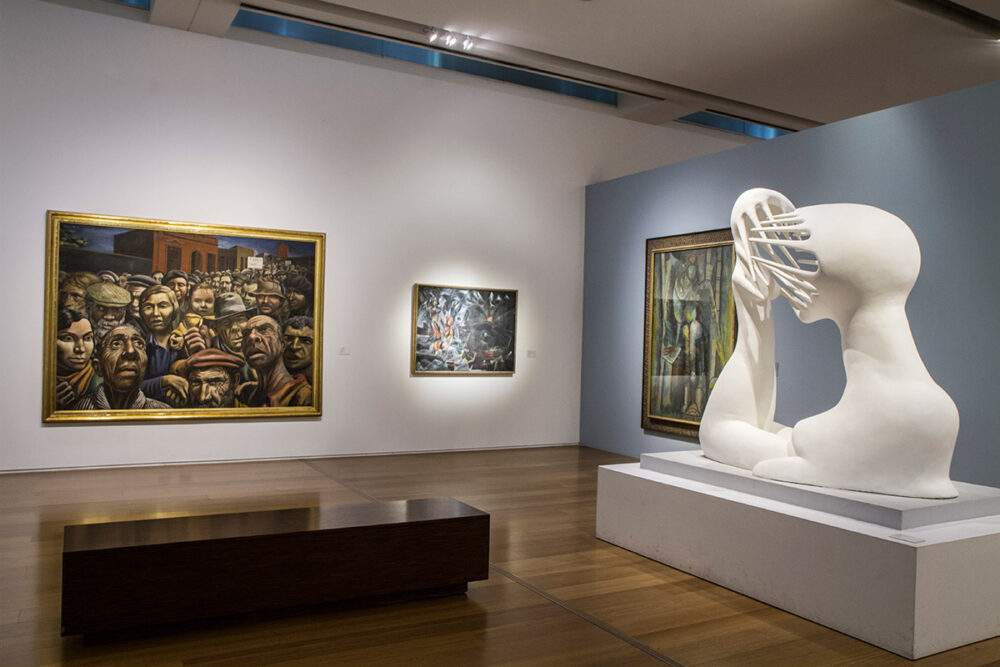Argentina’s cosmopolitan capital combines grand European-style architecture with a quintessentially Latin American zest for life.

Tango dancers entertain on-lookers along the Caminito (Photo: Maggi Bautista via Flickr / CC BY-SA 2.0)
The former can be seen in the stately 19th-century buildings, grand theatre and opulent townhouses that line the city’s leafy boulevards, while the latter is evidenced in its residents’ passion for tango music and a nightlife scene that runs into the early hours. For the full Buenos Aires experience, first-time visitors should endeavour to embrace every facet of the city – and here are 10 essential attractions that you just can’t miss.
The Caminito
Walking through the La Boca neighbourhood of Buenos Aires one can feel a world away from the wide avenues and palatial plazas of the city centre. The buzzing port district’s main focal point is the Caminito, a narrow alley lined with brightly painted zinc shacks that have housed the area’s large – and primarily Italian – immigrant population since the end of the 19th century. A veritable open-air museum, the street is today one of the city’s most popular tourist spots, dotted with restaurants where tango and folk dancers perform for the enjoyment of diners and souvenir shops and street vendors peddle their colourful wares. On match days, the neighbourhood also throngs with soccer pilgrims on their way to the sporting temple of La Bombonera (see below).
La Boca
Recoleta Cemetery

Recoleta Cemetery, the final resting place for many of Buenos Aires’ well-heeled elite (Photo: Phillip Capper via Flickr / CC BY 2.0)
There are only a handful of cemeteries around the world that are considered tourist attractions in their own right, and one of them can be found in the well-to-do Buenos Aires neighbourhood of Recoleta. Featuring thousands of statues, mausoleums, fairytale grottoes, sarcophagi, and small elegant houses, Recoleta Cemetery is the final resting place not only for Argentina’s moneyed elite but some of the country’s most iconic and celebrated figures – most famously among them the late politician Eva Peron, whose remains and the house in which they are kept draw a steady stream of visitors Open daily, on Tuesday and Thursday mornings the cemetery runs free tours in English.
Junín 1760, Recoleta / Mon-Sun 9am-5pm
Plaza de Mayo
Named after the 1810 revolution that took place here, leading to Argentina’s independence, Plaza de Mayo is the city’s oldest public square and a major focal point for both locals and tourists alike. The former – particularly its younger cohort – come to congregate for social gatherings, while the former flock here to see the many historic landmarks that line the square, including the House of Government, the National Bank, the Cabildo museum, and, towering 18 metres high at the centre of the square, the Píramide de Mayo monument, which commemorates the revolutionary architects of Argentina’s independence.
The Obelisco

The imposing sight of the Obelisco (Photo: Jesus Alexander Reyes Sánchez via Flickr / CC BY 2.0)
Frequently featured on postcards and other tourism paraphernalia, the Obelisco is perhaps the city’s most recognisable tourist attraction, soaring some 67 metres above the Plaza de la República on bustling Avenida 9 de Julio. Constructed in 1936 on the 400th anniversary of the first Spanish settlement on the Río de la Plata, the monument can be seen from miles around but is perhaps most impressive when standing at its base. During major sporting occasions, the historic landmark also becomes a magnet for tens of thousands of revellers who descend here to throng the streets in victorious celebration.
Avenida 9 de Julio
Puerto Madero
Built in the late 19th century alongside the Rio de la Plata as the main port of arrival for commercial vessels coming into Buenos Aires, Puerto Madero was soon rendered obsolete as ships grew in size and swiftly fell into a state of disrepair. Today, however, after great efforts to restore the area, it has burgeoned into one of the city’s most exclusive neighbourhoods. Dotted with cafes and restaurants, it is a hive of activity, with the lively promenade making for a pleasant stroll at all times of day. Among the district’s main attractions are the architecturally striking Puente de la Mujer (Women’s Bridge), designed by artist Santiago Calatrava, as well as two military ships moored at the docks housing exhibits chronicling their distinguished history.
The Bombonera

Packed crowds at La Bombonera (Photo: Victor Forjaz via Flickr / CC BY-SA 2.0)
For football hipsters, there are few more coveted bucket list stadiums than The Bombonera. Located in the heart of La Boca neighbourhood, the arena is home to Boca Juniors, one of South America’s most famous football clubs and is renowned the world over for its fanatical fans whose support is passionate enough to almost suck the ball into the net for their beloved team. Tourists can buy tickets for the ‘visitor’ section high up in the stands, but for a more authentic experience you can befriend a local who will help you land a spot behind the goal among a relentless wall of colour and noise. If you can’t make it to a game, there are also daily guided tours of the stadium that include entrance to the club museum.
Brandsen 805, La Boca
San Telmo Market
There’s no better way of getting under the skin of a place than by taking in the sights, sounds and aromas of a local market. First opened in 1897 and today an officially designated national historic monument, San Telmo Market can trace its origins back to the fresh wave of immigrants arriving from Europe at the time – whose legacy can still be seen in the indoor market’s typical Italian façade, which along with the original beams, arches and grand dome in its centre positively ooze character and charm. To experience the market at its bustling best, visit on Sunday when crowds pack the hall perusing everything from fresh fruit and spices to antiques, crafts, records, and toys.
Carlos Calvo & Defensa / Tues-Fri 10.30am-7.30pm Sat-Sun 9am-8pm Closed Mon
Teatro Colón
Revered among opera aficionados the world over for its stunning acoustics, Teatro Colon is one of the jewels in the crown of Buenos Aires’ rich cultural scene. Built in 1908, the theatre is also considered an architectural masterpiece, with its vast entrance hall, French-inspired room in Baroque style, and hand-painted dome formed by visually arresting stained glass windows. But the main attraction is undoubtedly the venue’s concert hall with its 4,000 elegant red velvet seats, which can be seen at close quarters by booking tickets for one of the theatre’s regular opera, ballet or symphony performances or during a guided behind-the-scenes tour which run daily.
Tucumán 1171
The Latin American Art Museum of Buenos Aires

An exhibition space at the Latin American Art Museum of Buenos Aires (Photo: The Latin American Art Museum of Buenos Aires)
Another of the city’s most prestigious cultural institutions, the Latin American Art Museum of Buenos Aires is home to a remarkable collection of paintings, sculptures, drawings, engravings, collages, photographs, installations and objets d’art by a wide range of Latin American artists. Highlights of the museum’s permanent collection include works by such notable figures as Frida Kahlo, Diego Rivera, Joaquín Torres-García, Jorge de la Vega and Guillermo Kuitca. The museum also hosts a busy programme of film screenings, talks, seminars and book presentations.
Av. Pres. Figueroa Alcorta 3415 / Weds 11am-8pm Thurs-Mon 12pm-8pm Closed Tues
Café Tortoni
Along with distinctive architecture, the Europeans also brought to Buenos Aires a vibrant café culture. Opened in 1858 on the fringes of the San Telmo district, the French-style Café Tortoni is said to be the oldest coffee shop in Argentina and over the years has been a favoured haunt of eminent cultural figures, from tango dancers to politicians to literary types. Marble tables and Tiffany lamps are dotted throughout the café and the walls are adorned with portraits of famous Argentines past and present. There’s also a small back theatre and a basement where tango shows are held in the evenings.
45 Rue de Saintonge / Tues-Sun 11am-6.30pm Closed Mon